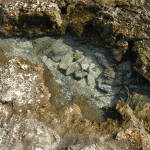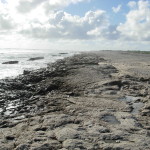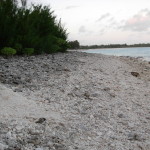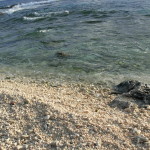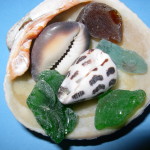Wake Beaches
 For a small atoll of less than four square miles total land mass, Wake Island has a lot of beach. Together Wake, Peale and Wilkes form a narrow wishbone-shaped coral island that opens wide to the west. Linear distance tip to tip to tip is about ten miles, but altogether the coastline – including both sea-facing and lagoon shores – exceeds twenty miles. Comprised entirely of bleached, broken coral and ledges, none of it is “barefoot beach,” but it has a striking beauty all of its own.
For a small atoll of less than four square miles total land mass, Wake Island has a lot of beach. Together Wake, Peale and Wilkes form a narrow wishbone-shaped coral island that opens wide to the west. Linear distance tip to tip to tip is about ten miles, but altogether the coastline – including both sea-facing and lagoon shores – exceeds twenty miles. Comprised entirely of bleached, broken coral and ledges, none of it is “barefoot beach,” but it has a striking beauty all of its own.
As the U.S. Marine detachment prepared defenses on Wake Island in late 1941 they established strongpoints on each of the three points with shore batteries and antiaircraft guns. A land invasion, however, might come stealthily along any of many miles of shoreline and there were insufficient men and guns to guard all of it. During the sixteen-day siege of Wake in December 1941, the long beaches were heavy burdens to the defenders, especially at night when jittery watchmen stood patrol. Sure enough, when the Japanese invasion commenced on December 23, it came stealthily at night, along the south beach.
Flotsam and jetsam, ever present on the sea, appear in disturbing amounts in our times. Most of us ignore the fact that a vast raft of garbage floats in the Pacific, but Japan’s tsunami debris washing ashore in Hawaii and along the West Coast captures media attention. The stewards of Wake Island conduct frequent beach cleanup missions along their shores, but Wake does not appear to be in the direct path of the tsunami debris. The casual beachcomber on Wake may hit stretches of pristine beach, but one never knows what the tide may have brought in the night before. I walked the beaches often during my short stay on Wake in the fall of 2011 and saw everything from old barrels and boxes to brightly-colored shoes. Some debris is actively sought: blue glass fishing floats still occasionally wash ashore and pieces of sea glass, tossed and turned to a smooth, milky finish, make a colorful complement to a shell collection.
Living near Lake Coeur d’Alene in North Idaho I am familiar with the seasonal rise in beach debris. After a winter of heavy snow, the spring melt will raise the lake quickly and capture all manner of logs, loose docks, and junk from high on the shore. Then, as the water recedes to summer level the debris is left on the beaches. In the Pacific storms and surges are frequent and the sea may throw its “take” right back or take its time finding a new shore. Photographs of post-storm Wake over the years show enormous piles of debris on the beaches, washed up against structures, and filling any open cavity. There is no high ground on Wake.
Building for War opens with a typhoon hitting Wake Island in the fall of 1940. “The ill-tempered glutton chewed up Wake, swallowed some, and spat out the rest, littering the narrow beaches with splintered wood, gasoline drums, and dead rats.” When the Pioneer Party of contractors arrives in January 1941, they find a tangled mess of debris. “Their first job was to clear the area of the ‘unholy alliance’ of typhoon-tossed gasoline barrels and dynamite. The men gingerly carried the sticks of dynamite some distance down the beach to explode them safely.” (Building for War, 58)
I’ll take a piece of blue-green sea glass any day.

